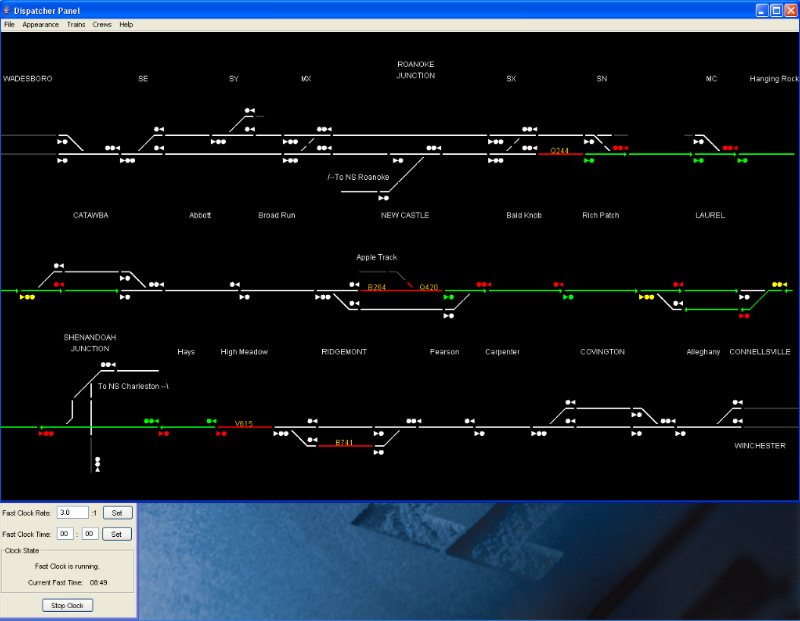Work Continues on the Shenandoah Division
Since the 03/19/2005 Operating
Session, I've been spending most of my time working on issues which surfaced
during that session. Most of my efforts on the railroad over the past couple of
months don't have visible results to show here in a progress report, but I
thought I'd briefly mention a few areas where work has been done.
Challenges of Mountain Railroading
Mountain railroading with long trains proved to be a challenge at the first
operating session, especially since management neglected to pay attention to
some of the established rules.
Discussion with various crew members have resulted in some changes to
operating procedures to use of pushers on all trains over 25 cars long traveling
in either direction over Rich Patch Mountain between New Castle, Va. and Laurel,
Va. The pushers will be used to push trains up the mountain and keep the
couplers bunched to reduce forces on draft gear at the head-end of trains. The
pusher locomotives will also provide "dynamic braking" assistance to all
southbound trains headed downgrade in order to stretch the slack in the
couplers. Three "mini"-operating sessions have been held over the last two
months to test the operation of the pushers and to give crew members some
experience with this facet of mountain railroading. The tests have proven quite
successful.
In addition, the CSXT Mechanical Department forces at the North Salem
Shops have been busy placing additional cars with body-mounted couplers into
service and making repairs to any cars identified as having issues during
the "mini"-operating sessions.
Finally, the Operating Department has agreed to reduce all train lengths
so all trains operating on the Shenandoah Division will fit into the passing
sidings at New Castle, Va.
and Laurel, Va. This change has been implemented in order to
increase fluidity on the railroad, which the dispatchers and train crews
alike will appreciate. As the crew becomes more proficient in moving traffic
across the Shenandoah Division, this restriction will be lifted, at least for merchandise trains.
Computer Assisted Traffic System (CATS) Software Installed
Effective Wednesday, May 4, 2005, CSX Transportation signal engineers and
signal maintainers have completed the upgrade of the software used by train
dispatchers on the SD desk in Jacksonville, FL. Prior to the upgrade, train
dispatchers used a manual DTC system implemented in MS Excel to track train
movements on the Shenandoah Division. Thanks to the generosity of the management
and crew of the
CRANDIC Railroad, the SD desk now has a working installation of the
Computer Assisted Traffic System (CATS) to control traffic movement across the
Shenandoah Division.
This upgrade was made possible by the delivery of a LocoBuffer-II-f from RR-CirKits
on Monday, May 2, 2005. This piece of hardware allows a PC to interface with the
Digitrax LocoNet. On the day of delivery, the chief signal engineer of the
Shenandoah Division used the hardware to connect the PC at the SD desk to the
railroad and was able to use the JMRI (Java Model Railroad Interface) software
to query various installed Digitrax components.
With some technical support from the lead CATS developer, configuration of the
CATS system resumed. On Wednesday, May 4, 2005, the system was activated for the
first time while connected to the railroad. Two trains were run from Wadesboro
to Winchester and return to verify the track occupancy detection did indeed work
and was visible in CATS.
On Wednesday, May 11, 2005, three members of the operating crew came over for a
"mini"-operating session. I served as the SD dispatcher in Jacksonville, and I
used CATS to control the train movements of two train crews plus the pusher
crew. The system worked quite well during this beta testing, and we're looking
forward to exercising it more fully at the next operating session.
This software will support DTC operations on the Shenandoah Division before the
eventual proposed conversion to CTC.
CSXT management is very excited about this new software and its use in
operations over the Shenandoah Division. A big thanks to Pat Lana and Rodney
Black of the
CRANDIC Railroad for graciously providing the CATS software for use on the
CSXT Shenandoah Division!
Fascia Installation Continues
Cherie and I have done some additional work on installation of fascia around
the railroad to try to complete this project. I've installed the remaining
fascia at the Norfolk Southern Roanoke staging yard. In addition, most of the
fascia has been installed at the back entrance to the layout, and Cherie has
painted this fascia with an initial coat of primer.
|

This picture shows the SD Dispatcher's Panel operating under the CATS
software. In this view, northbound train Q244 has been cleared to leave
North Salem for Catawba. The B264 pusher is on the rear of northbound
hotshot Q420, and the dispatcher has cleared the train up Rich Patch
Mountain to Laurel. Southbound coal train V615 has just passed B741, the
southbound Black Cat shifter, at Ridgemont. V615 has been given
clearance to the passing siding at Laurel where it will meet Q420 and
receive assistance down the mountain from B264.
The white lines on the diagram indicate sections of track which have
occupancy detection, while the dark grey lines are locations which do not
have detection. The red lines are occupied blocks, while the green lines
indicate future movements. Currently, the panel provides the dispatcher the
ability to use Direct Traffic Control (DTC) blocks to control traffic
movement. As signaling hardware begins to be installed on the Shenandoah
Division, this same software will be used to control signals and turnouts by
the dispatcher.
This pictures also shows the Fast Clock tool provided by the Java Model
Railroad Interface (JMRI) software so the dispatcher can see the current
time reflected from the LocoNet Fast Clocks installed in the layout rooms.
Click
here or on the image above to see a larger, crisper picture of the
dispatcher's panel (about 390K).
|